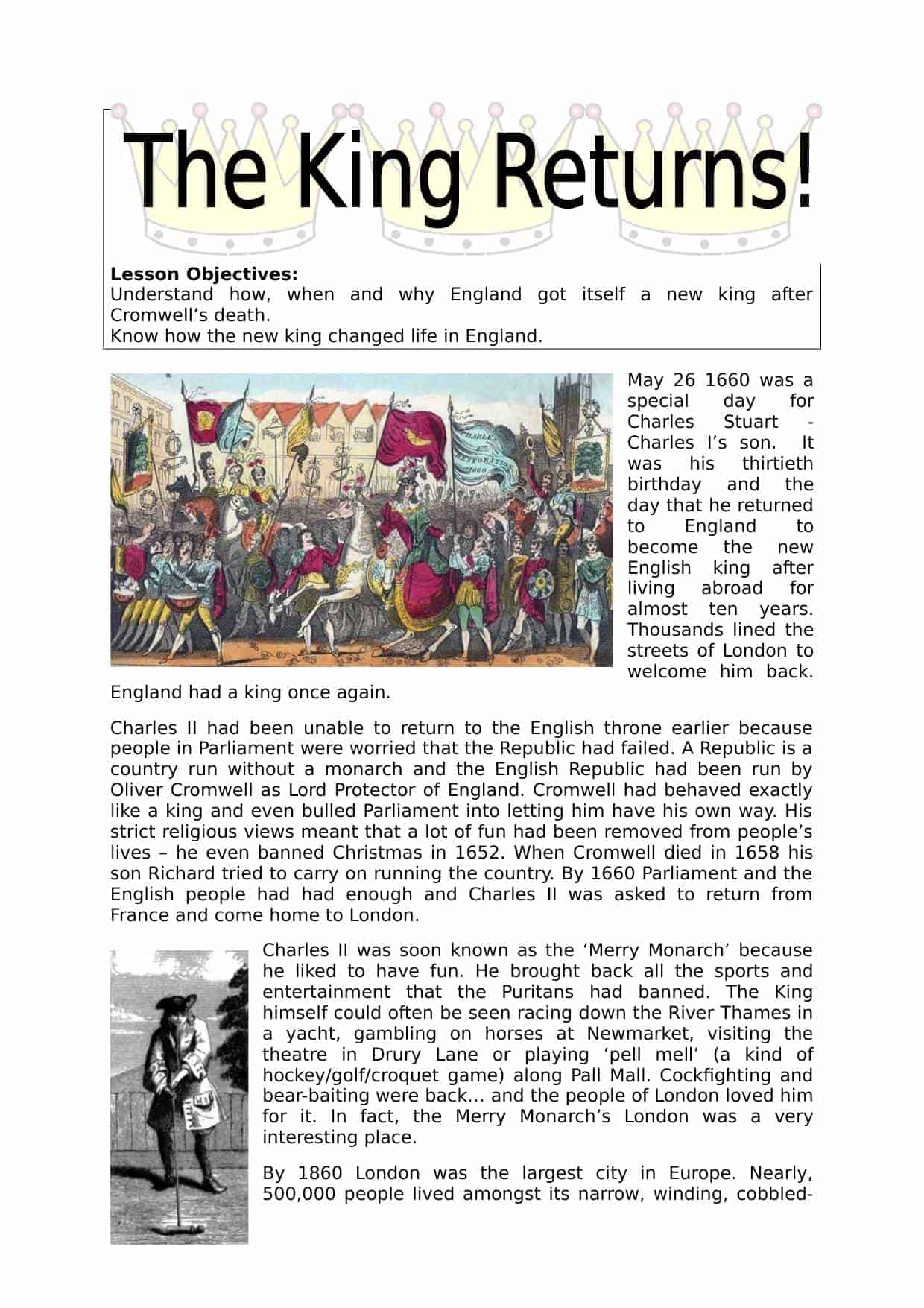Download Charles Stuart As King Worksheet
Click the button below to download this worksheet for use in the classroom or at home.
Download →
Lesson Objectives:
- Understand how, when and why England got itself a new king after Cromwell’s death.
- Know how the new king changed life in England.
Lesson Snapshot:
May 26 1660 was a special day for Charles Stuart – Charles I’s son. It was his thirtieth birthday and the day that he returned to England to become the new English king after living abroad for almost ten years. Thousands lined the streets of London to welcome him back. England had a king once again.
Charles II had been unable to return to the English throne earlier because people in Parliament were worried that the Republic had failed. A Republic is a country run without a monarch and the English Republic had been run by Oliver Cromwell as Lord Protector of England. Cromwell had behaved exactly like a king and even bulled Parliament into letting him have his own way. His strict religious views meant that a lot of fun had been removed from people’s lives – he even banned Christmas in 1652. When Cromwell died in 1658 his son Richard tried to carry on running the country. By 1660 Parliament and the English people had had enough and Charles II was asked to return from France and come home to London.
Charles II was soon known as the ‘Merry Monarch’ because he liked to have fun. He brought back all the sports and entertainment that the Puritans had banned. The King himself could often be seen racing down the River Thames in a yacht, gambling on horses at Newmarket, visiting the theatre in Drury Lane or playing ‘pell mell’ (a kind of hockey/golf/croquet game) along Pall Mall. Cockfighting and bear-baiting were back… and the people of London loved him for it. In fact, the Merry Monarch’s London was a very interesting place.
By 1860 London was the largest city in Europe. Nearly, 500,000 people lived amongst its narrow, winding, cobbled-stoned streets. As the city had grown, new houses sprang up all over the place. The tall, wooden houses were tightly packed together – leaving little space for fresh air or sunlight to break through. In fact, in some cases, the top floors of houses on opposite sides of the street nearly touched each other.
During the day London was a noisy, busy, hectic place packed full of people selling goods, running errands or enjoying one of the city’s smoke shops or coffee houses.
At night, London could be extremely dangerous. Thieves and robbers lurked in dark alleys and drunken brawls were heard all night long. Conmen, beggars and prostitutes pestered people constantly and pickpockets stole from any unsuspecting citizen.
The streets were full of rubbish too – and open sewers ran through the middle of them. Rats and fleas were everywhere. There were no toilets as we know them, just a hole in the ground or a bucket that you emptied into the street when it got full. Water came from street pumps that took the water straight from the River Thames. All the filth from the street washed into the river. It would have been bad enough to wash your clothes in water from a pump in 1660, let alone drink it! It is a wonder that only one person in ten lived to the age of 40!
Nobody really understood the link between dirt and disease as we do today and by 1665, London was one of the filthiest places in England. That summer was unusually hot, so the city must have been very smelly indeed. The hot, moist, filthy atmosphere was a perfect breeding ground for germs.
This was Charles II’s new London.
Worksheet Lesson Plan:
- Aimed at Students studying across UK Year 7,8 & 9 or equivalent
- Premium resource
- Use as you wish in the classroom or home environment
- Lesson plan on Charles Stuart as King of England.
- Contains questions throughout the study worksheet.
